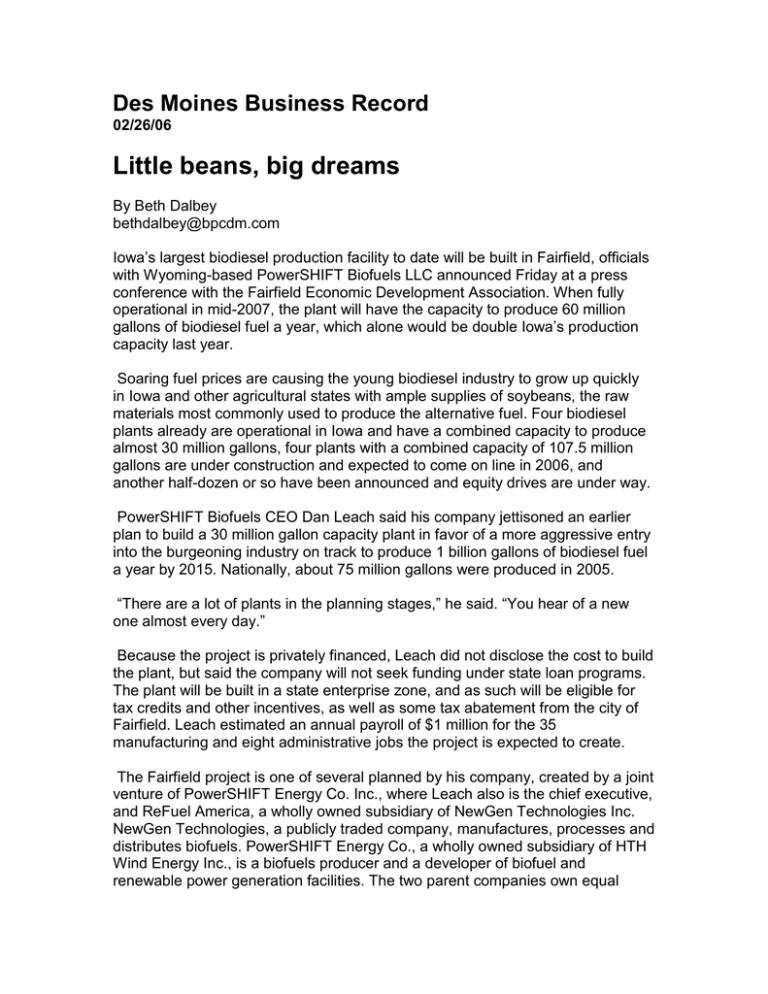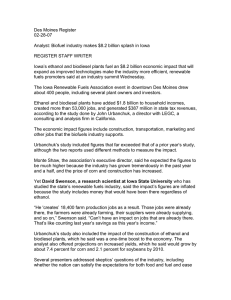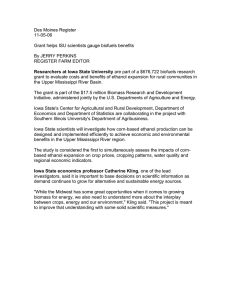Little beans, big dreams Des Moines Business Record
advertisement

Des Moines Business Record 02/26/06 Little beans, big dreams By Beth Dalbey bethdalbey@bpcdm.com Iowa’s largest biodiesel production facility to date will be built in Fairfield, officials with Wyoming-based PowerSHIFT Biofuels LLC announced Friday at a press conference with the Fairfield Economic Development Association. When fully operational in mid-2007, the plant will have the capacity to produce 60 million gallons of biodiesel fuel a year, which alone would be double Iowa’s production capacity last year. Soaring fuel prices are causing the young biodiesel industry to grow up quickly in Iowa and other agricultural states with ample supplies of soybeans, the raw materials most commonly used to produce the alternative fuel. Four biodiesel plants already are operational in Iowa and have a combined capacity to produce almost 30 million gallons, four plants with a combined capacity of 107.5 million gallons are under construction and expected to come on line in 2006, and another half-dozen or so have been announced and equity drives are under way. PowerSHIFT Biofuels CEO Dan Leach said his company jettisoned an earlier plan to build a 30 million gallon capacity plant in favor of a more aggressive entry into the burgeoning industry on track to produce 1 billion gallons of biodiesel fuel a year by 2015. Nationally, about 75 million gallons were produced in 2005. “There are a lot of plants in the planning stages,” he said. “You hear of a new one almost every day.” Because the project is privately financed, Leach did not disclose the cost to build the plant, but said the company will not seek funding under state loan programs. The plant will be built in a state enterprise zone, and as such will be eligible for tax credits and other incentives, as well as some tax abatement from the city of Fairfield. Leach estimated an annual payroll of $1 million for the 35 manufacturing and eight administrative jobs the project is expected to create. The Fairfield project is one of several planned by his company, created by a joint venture of PowerSHIFT Energy Co. Inc., where Leach also is the chief executive, and ReFuel America, a wholly owned subsidiary of NewGen Technologies Inc. NewGen Technologies, a publicly traded company, manufactures, processes and distributes biofuels. PowerSHIFT Energy Co., a wholly owned subsidiary of HTH Wind Energy Inc., is a biofuels producer and a developer of biofuel and renewable power generation facilities. The two parent companies own equal shares of PowerSHIFT Biofuels, a company that NewGen Technologies chief executive S. Bruce Wunner said reflects the tremendous demand for biofuels and other renewable energy sources in the United States. Leach said rail access and an untapped local soybean market made Fairfield an ideal location for his company’s first venture. Oil – primarily soybean oil, but also canola oil and corn oil when they are available – shipped in by rail will be used initially in the transesterification process, but he said there’s an even chance PowerSHIFT Biofuels will in the future be able to produce at least part of its oil by building a plant to crush the soybeans. “We haven’t pursued it, but we’ll be doing a feasibility study in Phase II,” Leach said. “It depends on farmer support. There’s not an active soybean pressure I know of in Southeast Iowa.” With the nation’s largest soybean production base, Iowa is well positioned to become a leader in biodiesel production, said John Miranowski, an Iowa State University economics professor. He expects the industry grow rapidly, especially if high fuel prices persist. “If crude oil prices stay in the $50-$60 [per barrel] range, biodiesel [is] reasonably competitive, because you can produce it cheaper than petroleumderived products,” he said. “I think we’re at a point we’re going to see biofuels take off, or continue the rapid growth seen in the ethanol industry since 2001. I don’t look for the price of gasoline to fall much below $2 per gallon, and I don’t see the price of diesel dropping.” Full funding of incentives in the Energy Policy Act of 2002 could fuel rapid expansion of the industry, Miranowski said. Congress set a goal of expanding the amount of renewable fuels, including biodiesel and ethanol, to 5 billion gallons in 2012 and included in the legislation $16 billion in tax incentives for both energy production and energy efficiency. The U.S. Environmental Protection Agency this year will begin implementing sulfur emission regulations placed on diesel in the Clean Air Act of 1990, and that could add the same buoyancy to the biodiesel industry as health concerns about the fuel additive MTBE (methyl tertiary butyl ether) did for ethanol production. Biodiesel is recognized as a cleaner-burning fuel than petroleum-based diesel and can be used in any diesel engine with few or no engine modifications. “I think we’re at a point where we’re going to see the biofuels take off, or continue the rapid growth seen in the ethanol industry since 2000,” Miranowski said. “The ethanol industry is much further down the road, but it struggled for 20 years.” However, Miranowski doesn’t expect the biodiesel industry to grow quite as quickly as ethanol because an acre of corn yields about three times the amount of raw product as an acre of soybeans. A bushel of soybeans will yield 1.4 gallons of biodiesel, while a bushel of corn will yield 2.7 gallons of ethanol. “In that sense, they’re getting a lot more ethanol per acre of corn than we’re getting in biodiesel from an acre of soybeans,” he said. “When you think of it that way, we don’t have the potential for expansion in Iowa that we do for ethanol, but we’re a long way from what we could sustain in this state with soybeans and animal fat.” State government officials have touted the potential of biodiesel and other alternative fuels to make Iowa a net exporter of energy within five to seven years, which Miranowski said would revitalize rural areas in the process. An addition of three or four dozen jobs, as is expected with the Fairfield biodiesel plant, may not be noticeable in urban areas, but “for a lot of rural Iowa, this is a big thing,” he said. The Iowa Soybean Association, which recently commissioned a Pennsylvania company to study the effect of the expanding biodiesel industry on the state, expects it to pump an additional $141 million in tax revenues into state coffers between now and 2010. That study also showed that the biofuels industry will invest more than $417 million to build new biodiesel production plants and more than $2.5 billion in related inputs, labor, and goods and services to produce biodiesel by 2010. “The impact of this spending will add more than $3.6 billion to the Iowa economy between 2006 and 2010, put an additional $3.6 billion of income into the pockets of Iowa households, and create almost 13,800 new jobs in all sectors of the economy by 2010,” said John Urbanchuk, director of LECG LLC, the company that conducted the study. Part of the growth of the industry is expected in the development of co-products from the glycerin byproduct created in the transesterification process, especially as biorefineries become more sophisticated, Miranowski said. Glycerin is frequently used in soaps and cosmetics, but new uses are being developed as the biodiesel industry grows. For example, a researcher at the University of Missouri-Columbia recently developed a process to convert glycerin into propylene glycol, which can be used as a non-toxic antifreeze for vehicles. “Even with biodiesel, they are bringing off a lot of co-products that may be higher value,” he said. “To me, that’s going to be a major driver in the future.” Iowa isn’t the only state pinning economic development hopes on the development of biofuels. Texas has 11 commercial biodiesel plants with a combined production capacity of 104 million gallons currently in operation, and more are in the works. Minnesota, California and Mississippi are also aggressively pursuing biofuel refinery developments, but Iowa has a chance to lead the nation, said Michael Ott, executive director of the non-profit BIOWA Development Association, a consortium of businesses that helps biofuel companies arrange financing and assists in issue related to construction and technology. “Right now, most of our energy comes from the Middle East from nonsustainable sources,” he said. “We can actually produce energy, which is different than acquiring it. We can grow it, and we can do that year after year. As the industry grows up, Iowa is poised to become a leader. “We are way ahead of the curve on this one,” he said. “I like being in that position.”



